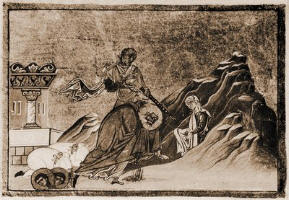
The Works Of Dionysius The Areopagite Volumes 1 & 2
SECTION II
But we must keep our discourse within bounds, and must search, in our first explanation of the types, for what reason the Word of God prefers the sacred description of fire, in preference to almost every other. You will find it, then, representing not only wheels of fire, but also living creatures of fire, and men, flashing, as it were, like lightning, and placing around the Heavenly Beings themselves heaps of coals of fire, and rivers of flame flowing with irresistible force; and also it says that the thrones are of fire; and that the most exalted Seraphim glow with fire, it shews from their appellation, and it attributes the characteristic and energy of fire to them, and throughout, above and below, it prefers pre-eminently the representation by the image of fire. I think, then, the similitude of fire denotes the likeness of the Heavenly Minds to God in the highest degree; for the holy theologians frequently describe the superessential and formless essence by fire, as having many likenesses, if I may be permitted to say so, of the supremely Divine property, as in things visible. For the sensible fire is, so to speak, in everything, and passes through everything unmingled, and springs from all, and whilst all-luminous, is, as it were, hidden, unknown, in its essential nature, when there is no material lying near it upon which it may shew its proper energy. It is both uncontrollable and invisible, self-subduing all things, and bringing under its own energy anything in which it may happen to be; varying, imparting itself to all things near it, whatever they may be; renewing by its rousing heat, and giving light by its uncovered illuminations; invincible, unmingled, separating, unchangeable, elevating, penetrating, lofty; subject to no grovelling inferiority, ever moving, self-moving, moving other things, comprehending, incomprehended, needing no other, imperceptibly increasing itself, displaying its own majesty to the materials receiving it; energetic, powerful, present to all invisibly, unobserved, seeming not to be, and manifesting itself suddenly according to its own proper nature by friction, as it were by a sort of seeking, and again flying away impalpably, undiminished in all the joyful distributions of itself. And one might find many characteristics of fire, appropriate to display the supremely Divine Energy, as in sensible images. The Godly-wise, then, knowing this, depict the celestial Beings from fire, shewing their Godlikeness, and imitation of God, as far as attainable.

 Keep Site Running
Keep Site Running